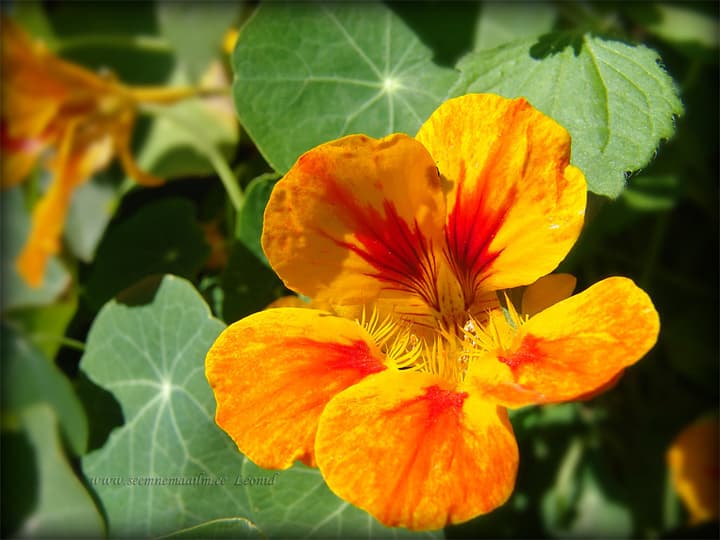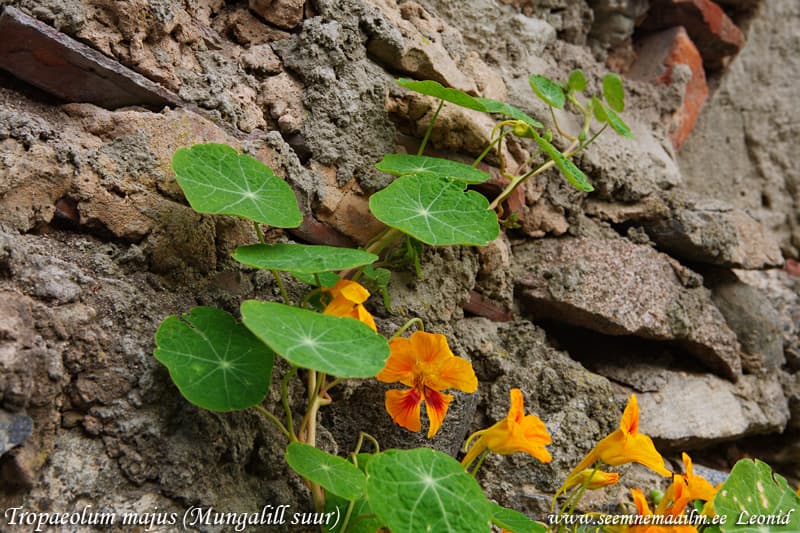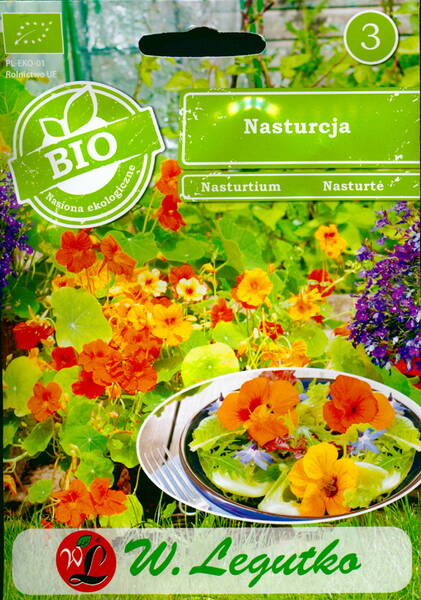Ecological seeds.
Beautiful annual plant of the Nasturtium family with bright flowers of rich color.
Height (length) up to 300 cm. Flower diameter up to 5 cm.
Widely used in vertical gardening. Sowing is carried out with seeds in the ground in May or through seedlings in April. Shoots appear in 10-14 days. Seedlings are planted in the ground when the threat of frost has passed. The distance between plants is 20-30 cm.
Flowering occurs 50-60 days after germination. Blooms in July - August.
Nasturtium is thermophilic, afraid of slight frosts, photophilous and unstable to drought. Grows on fertile soil to the detriment of flowering. It grows well and blooms profusely in boxes on balconies and windows, in concrete vases and containers.

Nasturtium prefers drained, well-fertilized, moderately moist soils. Plants do not tolerate fresh manure, lime and excess moisture, but with a lack of moisture in the soil, it grows poorly and almost does not bloom. On highly fertilized soils, the number of flowers decreases and the leaves develop rapidly. Nasturtium is thermophilic and photophilous, does not tolerate transplantation. It is better to plant it in sunny places, on moderately fertilized soil. In partial shade, it develops large leaves.
Nasturtiums are propagated by seeds. For early flowering, seeds in early May are sown in pots of 2-3 pcs. and put in a greenhouse or under a film. Sowing in boxes is undesirable, because it is worse than most flowers, tolerates transplantation. After the end of the frost, the seedlings are planted in open ground. With the onset of warm weather, seeds can be sown directly into open ground in a permanent place. Caring for nasturtium consists in regular watering and feeding before flowering.
Low-growing nasturtiums are good for curbs and path edges. Long-leaved nasturtiums are good for landscaping buildings, balconies, gazebos. When growing them on lawns, timely installation of supports is necessary.

In cooking, this plant is simply irreplaceable!
Fresh nasturtium leaves, hard flower buds and unripe seeds are used as food. In English-speaking countries, nasturtium is widely used to make vitamin salads and vitamin drinks.
Fresh leaves, hard flower buds, unripe green seeds have a pleasant spicy taste and are used as seasonings for salads, meat and boiled dishes.
Flower buds and green fruits are marinated with dill and vinegar. Nasturtium petals, mashed with garlic to a paste, with a small addition of salt and mayonnaise, can be used as an original spread for sandwiches.
With a light aroma, bright yellow nasturtium flowers are placed on dishes with assorted vegetables, fruit casseroles or other cold snacks.
Dried flowers are added to homemade wines, fragrant tea is prepared from them. Finally, dried, peeled and ground nasturtium seeds have a spicy, peppery flavor and are used as a seasoning for a wide variety of dishes.

Climbing nasturtium.
* Few people know that nasturtium has remarkable medicinal properties.
In its homeland in South America, it is used for almost a hundred diseases; this plant is also highly respected by European medicine...
All above-ground parts of nasturtium are exceptionally rich in vitamin C. Its content in fresh nasturtium leaves reaches 450 mg%, and in plant stems up to 100-150 mg% (for comparison: black currant berries and vegetable peppers contain approximately the same amount, and lettuce leaves - 10 times less). Nasturtium is also rich in carotene and sulfur, which have preventive effects against sclerosis and other diseases that affect older people. It contains a lot of iodine, potassium, and phosphorus. Nasturtium has a detrimental effect on pathogenic microbes, improves metabolic processes, and stimulates the body's defenses. All parts of the plant are used for medicinal purposes.
Nasturtium leaves have a strong antiscorbutic effect.
It is used for influenza, as a cold remedy, for diseases of the lungs and upper respiratory tract, for chronic bronchitis, because contains herbal antibiotics.
It is useful for metabolic disorders, for kidney stones and cholelithiasis, as a laxative, and for inflammatory diseases of the lymph nodes.
It is used for male and female menopause. And dried leaves and flowers relieve depression, feelings of depression and irritability.
To prepare the infusion you need to take 1 tbsp. spoon of crushed leaves, pour 1 glass of boiling water, leave for 30 minutes, strain. Take 0.3 cups 3 times a day.
In Western European countries, a wine infusion made from nasturtium leaves is widely used.
To prepare it, you need to fill a liter jar to the top with fresh nasturtium leaves, fill it with dry white wine, close the lid, leave in a dark place at room temperature for 2 weeks, strain. Take 1 teaspoon 3 times a day before meals when the vital forces of the body are weakened.
For diseases of the kidneys and urinary tract, incl. and for urolithiasis, a decoction of the whole plant is used. To prepare it, 1 tbsp. pour 0.5 liters of boiling water over a spoonful of leaves, buds and fruits, heat in a water bath for 15 minutes, leave for 45 minutes, strain. Take 0.5 cups 3 times a day. For chronic bronchitis, take 1 tbsp nasturtium juice. spoon 3 times a day. For the same purposes, an alcohol tincture of the whole plant is used. To prepare it you need 1.5 tbsp. spoons of crushed leaves with buds and seeds, pour 1 glass of vodka, leave in a dark place for 14 days, shaking occasionally. Take 25 drops 3 times a day.
An infusion of nasturtium flowers is used mainly for diseases of the cardiovascular system.
Nasturtium is widely used to treat stomatitis. To prepare the decoction 1 tbsp. pour a spoonful of crushed leaves and flowers into 1 glass of boiling water, heat over boiling water for more than 30 minutes, strain. Add 1 teaspoon of honey to the broth and rinse the mouth. The same remedy is used to gargle with a sore throat.
Juice from nasturtium leaves is used externally for itching and scabies, and also as a remedy against hair loss. A decoction of nasturtium leaves and fruits, as well as an alcohol tincture of nasturtium leaves and nettles, also help against hair loss.
In addition to its high decorative value, medicinal value and high taste, nasturtium also heals the earth well from fungal diseases.
And in cooking this plant is simply irreplaceable!
Fresh nasturtium leaves, hard flower buds and unripe seeds are used for food. In English-speaking countries, nasturtium is widely used to prepare vitamin salads and vitamin drinks.
Fresh leaves, hard flower buds, and unripe green seeds have a pleasant pungent taste and are used as seasonings for salads, meat and boiled dishes. Flower buds and green fruits are pickled with dill and vinegar. Nasturtium petals, ground with garlic to a paste, with a small addition of salt and mayonnaise, can be used as an original paste for sandwiches. Having a light aroma, bright yellow nasturtium flowers are placed on dishes with assorted vegetables, fruit casseroles or other cold appetizers.
Dried flowers are added to homemade wines and aromatic tea is prepared from them. Finally, dried, peeled and ground nasturtium seeds have a spicy, peppery flavor and are used as a seasoning for a wide variety of dishes.
* Nasturtium salad with radishes.
Wash nasturtium flowers and chop finely. Add radishes cut into slices, season with vegetable oil and table mustard.
For 20 g of nasturtium flowers - 70 g of radish, 1 tbsp. a spoonful of vegetable oil, table mustard, pepper and salt - to taste.















